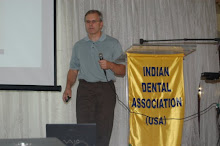Basic #1- Emphasis on dento-alveolar change
Orthodontic treatment predominately affects dento-alveolar structures. Growth modification (even if accomplished with functional appliances) results primarily in dento-alveolar development. It is true that some patients experience orthopedic changes, but the majority of change is still dento-alveolar.
Basic #2- The use of Light, Continuous Forces
Intermittent forces move teeth inefficiently. Heavy forces have been shown to damage root structure. Therefore, light, continuous forces maximize treatment efficiency. How can a practitioner be sure that he/she is using light, continuous forces? First never, never try to speed up treatment by forcing a wire into the bracket slot. Second, use a light, flexible wire until teeth are completely aligned (one of the most common mistakes I see is practitioners abandoning nitinol before alignment occurs). And third, use a wire progression that provides a slow increase in wire diameter so no wires are forced into the bracket slots.
Basic #3- Leveling and Aligning
If cases are leveled and aligned properly, mechanics become more efficient. About 1/2 the treatment time in a typical case is used to level and align (this includes bite opening or closing-see below). The following techniques aid in the leveling and aligning process:
-Use of nickel titanium archwires to relieve crowding.
-Use of bendbacks and lacebacks to control forward movement of incisors in extraction cases.
-Use of open coil springs to create space for blocked out teeth. When using open coil with the initial archwires, use only enough coil to provide a light force (the coil used is about 2mm wider than the space between the brackets where the coil is used). This will minimize distortion of the arch form.
-Early establishment and maintenance of arch form.
Basic #4- Overbite control
Getting the bite opened to the desired level before initiating other mechanics is a basic that many practitioners do not do. Strict adherence to this basic will really improve treatment results. The following procedures help the practitioner control overbite:
-Differential bracket positioning can account for about 5mm of bite opening, or 3mm of bite closing.
-In deep bite cases, bracket the 2nd molars early in treatment.
-Use of reverse and compensating curve (rocking chair curve) when the overbite is 6-9mm.
-Use tipbacks in a 2x4 or 2x6 set-up when the overbite is 10mm or greater.
-Be aware that in most cases, leveling and bite opening are not complete until rectangular wires have been in place for at least one month.
-Avoid leveling the Curve of Spee in open bite cases. Differential bracket positioning will greatly aid in maintaining the Curve of Spee.
Basic #5- Space Closure
A .019x.025 rectangular wire in a .022 bracket slot enables the practitioner to use sliding mechanics while minimizing archwire deflection and loss of torque control.
In most cases, en-masse space closure is preferred over canine retraction.
Many effective ways of providing force for space closure exist; elastics, chain, coil springs, and tie backs are most commonly used.
Basic #6- Overjet Correction
ClassII correction is accomplished by using a combination of ClassII elastics and functional appliances.
ClassIII elastics work well for mild to moderate ClassIII discrepancies.
Continuous forces on the dento-alveolar processes provide the best opportunity for overjet correction.
Basic #7 Finishing and Retention
Finishing involves correction of mistakes made earlier in treatment, particularly bracket position.
Let cases settle in light wires for at least 6 weeks prior to debanding.
Many practitioners advocate removing archwires for an additional 4-6 weeks to help determine retention needs for the case.
Retention is usually accomplished by using bonded retainers for the lower anterior segment, and acrylic full coverage upper retainers.
Wrap around upper retainers are used in cases that need additional settling; retainers with bite planes are use to retain deep bite corrections.
Final Considerations
#1 Position brackets properly. Pay attention to bracket positioning. Reposition brackets twice during treatment- after leveling and aligning (6-9 months into treatment) and before beginning finishing (4 months before removal).Use a panographic x-ray to evaluate bracket position when repositioning.
#2 Control arch width. Be aware of what you are trying to accomplish with arch width control (expansion, contraction, or maintenance of arch width). Co-ordinate all stainless steel archwires to accomplish your desired goals.
#3 The basic plan for most cases is to first gain control of the teeth (wire progression), then do mechanics, and finally, give up control (finishing and retention). Get the bite open with brackets properly positioned before initiating mechanics. If you follow this general outline, your treatment efficiency and effectiveness will greatly improve.

9 comments:
Wow ! Nice Blog... Thanks for this. Aava Dental provide the best
Dental Crowns services For tooth treatment for you and your
family.You Can also get more services from Aava Dental like :- Orthodontic Treatment , Dental Crown,Dental
Bridge,Dental Implants
I see the greatest contents on your blog and I extremely love reading them. orthodontic treatment glenfield
In orthodontic treatment, clear aligners and braces play an important role. The concept of clear aligners and braces is one thing to make curved teeth into straight teeth. Clear aligners, which reduce the risk of gum disease and tooth decay. Both have its own advantages.
Full mouth dental implants in Chennai
Full mouth implant treatment
Orthodontic Treatment
Pediatric Dentist in Chennai
Its awesome article, I read complete and knew more about orthodontics.
Full Mouth implants in India
Dental implants in India
Root canal specialist in Chennai
Kids dentistry near me
Get Rid Of Black Spots On Teeth
Straighten teeth without Braces
Nice article!
IELTS Coaching near me
Very nice detail about orthodontics
Nice post, thanks for sharing a wonderful informative information.
Orthodontics
Teeth Straightening Braces
Invisalign Dental
Post a Comment